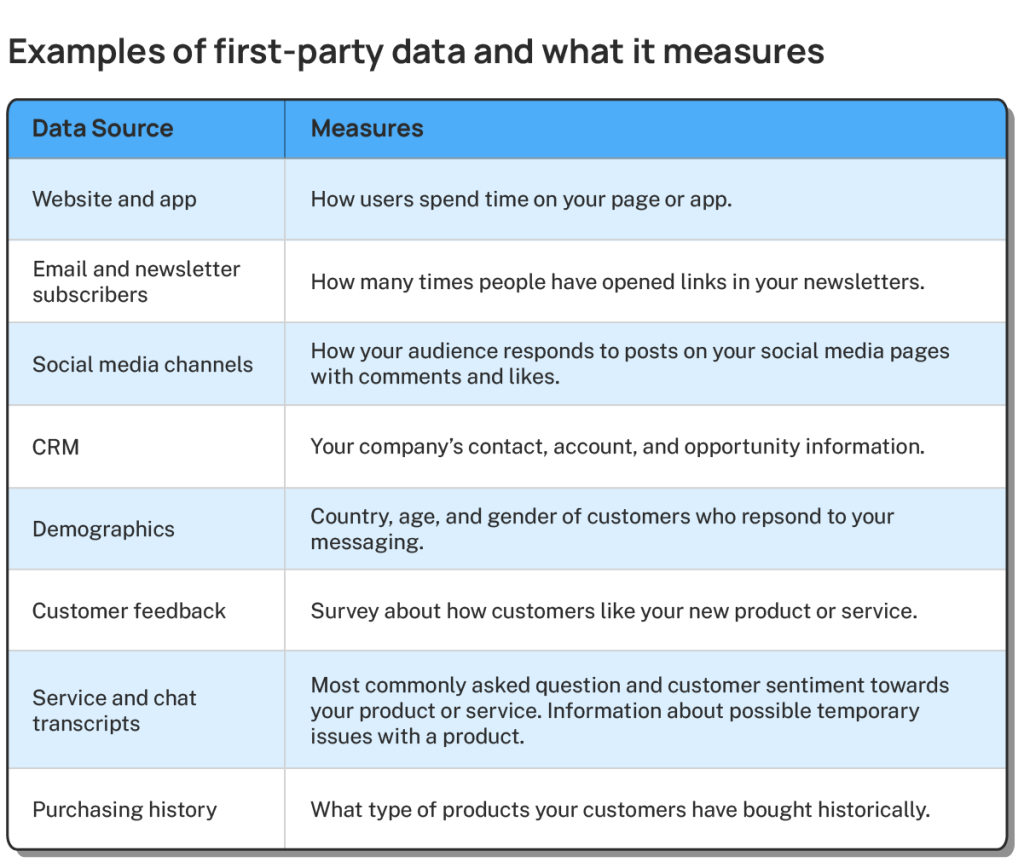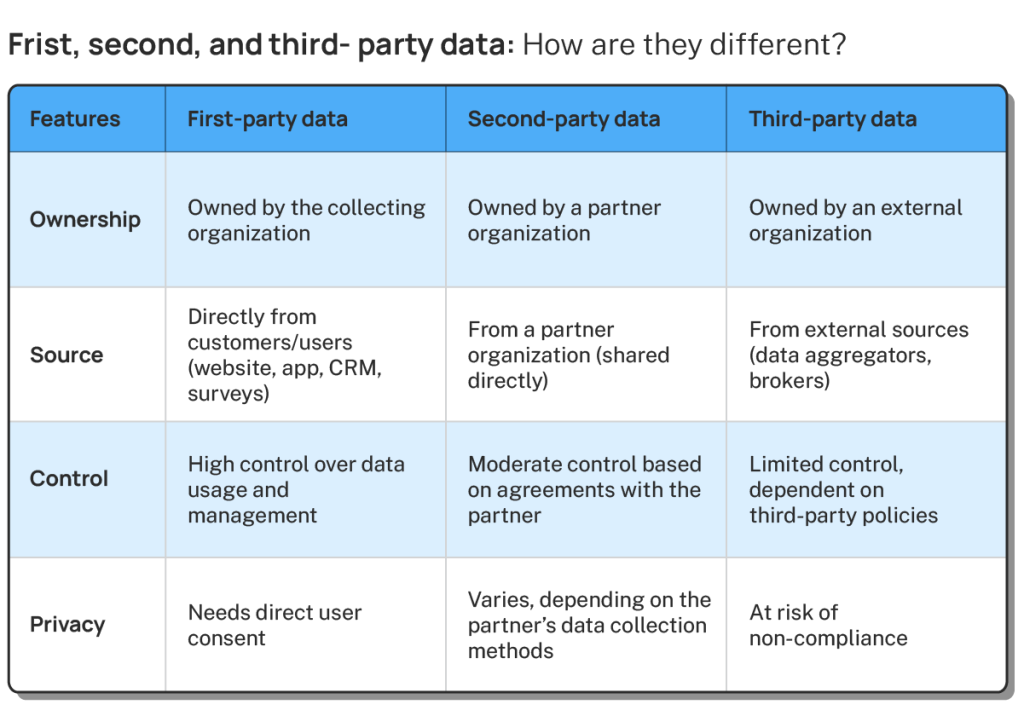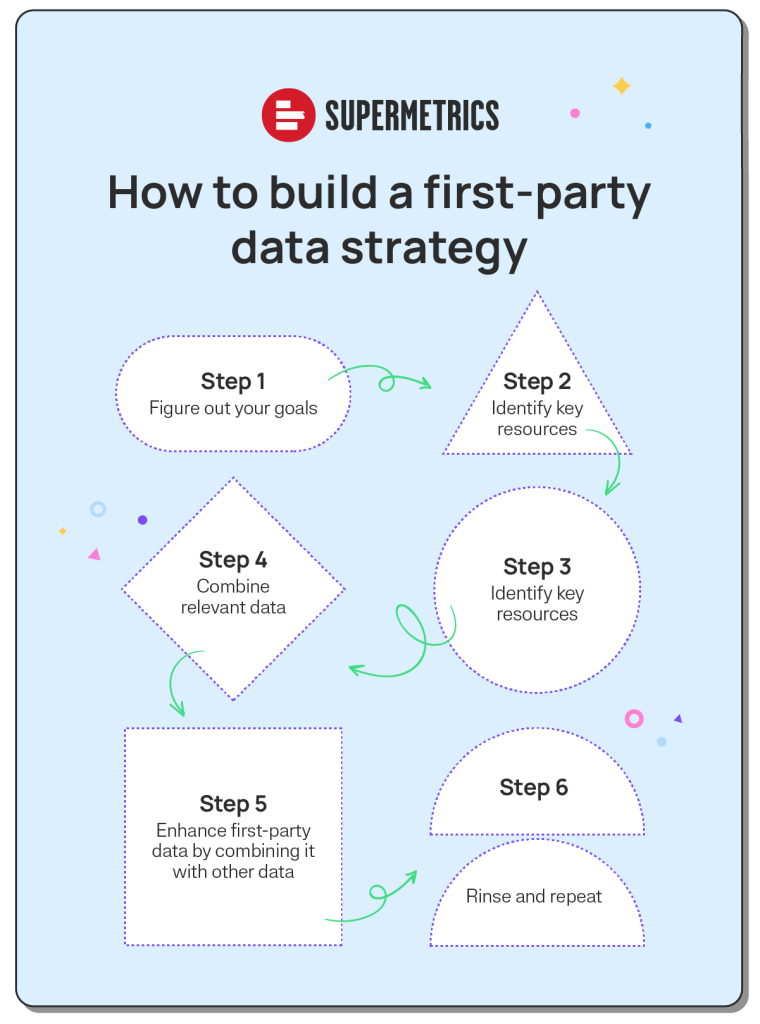Feb 22, 2024
First-party data strategy: The ultimate guide for marketers
9-MINUTE READ | By Pieter van Groenendael & Bani Kaur
[ Updated Feb 23, 2024 ]
The end of third-party cookies is a one-two punch for marketers. It’ll limit how marketers track and measure marketing and deliver targeted ads. Investing in a first-party data strategy will help marketers adapt beyond the cookie crumbles.
In this post, we’ll discuss everything you need to know about first-party data and how to take advantage of it.
Navigate this post:
- What’s first-party data?
- First-party vs. second-party vs. third-party data
- What can you do with first-party data?
- 6 steps to building a first-party data strategy
- Best practices for collecting first-party data
- The best way to store first-party data
What’s first-party data?
First-party data is information collected and owned by an organization from its channels. Typically, this includes specific details about transactions, events, or actions like form submissions rather than aggregated external data. First-party data is defined by two critical criteria:
- Consent: from subscribers and visitors
- Ownership: owned by the company

It’ll soon be impossible for marketers to track users without their consent. As of January 2024, Google has turned off third-party cookies for 1% of users and will disable them completely by Q3.
Digging into the nuances of first-party data and how they compare to second and third-party data can help you plan for an overarching first-party data strategy.
First vs. second vs. third-party data
The biggest differences between first, second, and third parties are who owns the data and how it is collected.

First-party data
Your company collects and owns this data.
- Ownership: owned by your organization
- Source: provided by your customers from your channels, including website, CRM, survey, etc.
- Control: you’ll have control over data usage and management
- Privacy: since it requires customer’s consent, it’s privacy-compliant
Second-party data
This is other company’s first-party data that you can acquire, typically through a partnership or a purchase. For example, you work with another company to run a lead-gen ebook initiative. Your partner is in charge of creating the ebook and collecting the leads while you’re promoting it. At the end of the campaign, you’ll get a list of contacts from them.
- Ownership: owned by a partner company but is shared with you through an agreement
- Source: directly from the partner company’s channels
- Control: you have moderate control over the data depending on your agreement
- Privacy: depending on the partner’s data collection methods
Third-party data
This is aggregated data collected and owned by a third party, for example, advertising platforms like Meta and Google.
- Ownership: collected and owned by a third party
- Source: various, often from websites, apps, public records, etc.
- Control: limited control, dependent on the platforms’ policies
- Privacy: at risk of non-compliance
What can you do with first-party data?
Besides being highly compliant, first-party data is a strategic differentiator since it’s unique to and owned by your company. You have endless opportunities to analyze it, feed it into different marketing measurement models, and use it to create highly targeted campaigns.
Let’s look at three use cases for first-party data.
Build your ideal customer profiles
The most popular use case we’ve seen for first-party data is building ideal customer profiles (ICP). As a business, it’s important to figure out who buys your products and how to get more of those customers. First-party data helps you understand:
- Who should you market and sell to?
- What factors encourage this customer to buy from you?
- How long is the journey between a customer hearing of you and making a purchase?
- How can you increase the value of our existing customers?
For instance, in a B2B context, where sales cycles are long, identifying leads that match the ICP ensures that marketing and sales efforts focus on prospects that are more likely to convert.
Improve marketing measurement
The industry is moving towards a privacy-first measurement approach, and first-party data gives you the freedom to measure and improve your marketing efforts without bypassing any regulations. It makes the perfect foundation for predictive analytics in marketing and marketing mix modeling (MMM)
Traditionally, predictive analytics based on third-party data was a step up from a shot in the dark—largely dependent on broad market trends. First-party data offers a direct line to the consumer—increasing the accuracy of your forecasts. Additionally, it helps improve the model’s accuracy and allows you to segment and target across every channel.
Create highly targeted campaigns with Conversion API
Conversion APIs, offered by platforms like Facebook and Google, allow you to send your first-party conversion data to the platforms so they can optimize campaigns for you. Using conversion APIs helps you:
- Create personalized marketing campaigns: since first-party data provides insights into your audience’s interests and behaviors when used with Conversion APIs, you can create highly personalized campaigns that resonate with your audience
- Comply with privacy regulations: because first-party data is collected directly from your customers with their consent, using it with Conversion APIs ensures that you can your advertising is privacy-compliant
6 steps to building a first-party data strategy

Step 1: Figure out the end goal
Don’t just focus only on the immediate results. Consider how first-party data will impact your long-term goals.
- Who are our customers, and what do they need?
- How can our first-data strategy evolve as the business grows?
- What’s our biggest challenge right now?
- What happens when we solve this challenge?
- What is our historical data telling us?
Once you’ve identified an end goal—whether it’s shortening sales cycles or optimizing your conversion rates—you can move on to the ‘how’.
Step 2: Identify the data you want to collect
The second step is identifying data that informs your goal. To understand which data to include, ask yourself:
- What data do we currently have?
- What are our data gaps? Where do we work from assumptions versus facts?
- Where is a historical analysis insufficient, and what do we need to supplement it?
Step 3: Assess your internal resources
It’s important to assess your internal resources—talents and technology capabilities—to see if there are any gaps. Ask yourself:
- Does your current data infrastructure support data integration and analysis at scale?
- Do you have a data warehouse or data lakes?
- Do you have the skills in-house to manage your data requirements?
- Do your marketing team have a specialist to take care of marketing data?
Once you’ve done this, you’ll have a better understanding of your company’s data literacy.
Step 4: Collect the data
When identifying the data you need, ensure you consider marketing data security and follow best practices. This will help you build trust with your customers and protect their data.
- Which customer data would be the most relevant to our use case?
- How will we collect this data?
- How will we store this data?
Step 5: Enhance first-party data by combining it with other data (for analysis and segmentation)
A lot of data strategists only work up to the previous step and leave out this part. That’s often because they can either inspect the data visually or manually perform a basic analysis with Excel formulas. But connecting relevant data for actionable insights is what distinguishes a strategy from an overview.
A first-party data strategy isn’t built in and of itself. It’s dependent on second and third-party data—which is where the process gets tricky. Filling this gap is your holy grail to driving the highest ROI on your marketing spend. Once you’ve identified which data to connect, you need reliable tools that integrate with your tech stack.
When evaluating tools for connecting data, ask:
- Where does our existing tech stack stand, and how prone is it to errors?
- To what extent is automation possible with our current tools?
- Which feature gaps do we need to fill to generate insights we can use?
- What level of support and training is offered by our data connector?
As your marketing needs evolve (and they will), you’ll need more support and customization to get the most mileage out of your first-party data.
When connecting relevant data, you also need to intentionally remove data points that could skew results. For example, an ecommerce company could remove behavioral data from the onset of COVID because it represents an anomaly.
Step 6: Rinse and repeat
A first-party data strategy isn’t set and forget. It requires constant optimization and governance. As your company grows, you’ll need to adapt your strategy. Additionally, marketing data governance is an important piece of the puzzle. This involves regular data audits to ensure the data you collect is relevant, privacy-compliant, and follows the company’s governance practices.
Best practices for collecting first-party data
Best practices for building a dependable first-party data strategy boil down to trust—via transparency, value exchange, privacy, and data quality.
Transparency
Being transparent when collecting first-party data helps you build trust with your customers. It’s all about respecting their privacy and data. You want to be open about:
- What data will you collect?
- Where will you store the data, and how will you keep it safe?
- How will you use the data?
Value exchange
Help customers understand how their data comes back to benefit them—usually as tailored recommendations and personalized offers. In a landscape of heightened privacy concerns, help your customers feel at ease by communicating proactively.
Security and privacy
Assure customers you’ll handle their data securely and in compliance with data protection regulations. First, establish clear data privacy policies and procedures and display them for your visitors. Second, obtain consent from customers when you’re collecting data and tell them how you’ll use it. Third, schedule time to learn and strategize for changes to privacy and compliance policies.
Ensure data quality and accuracy
Double-check that your data is accurate, reliable, and up-to-date. Incomplete or inconsistent data can give you unhelpful—or worse, biased—insights. To do this, create a system to govern the marketing data you generate and store. Then, regularly audit this system to ensure it removes duplicates, standardizes formats, and flags or fills in missing information.
Storing first-party data—Customer data platforms vs. data warehouses
There are two ways to store first-party data— marketing data warehouses and customer data platforms (CDP).
In addition to customer data, a data warehouse store can store data from other internal and external sources, including advertising, product, and transaction data. The key benefit of using a data warehouse is data ownership. You’ll own and have control over your data.
On the other hand, CDPs focus on customer data, which can be too narrow for a comprehensive first-party data strategy.
The best way to store first-party data is using a data warehouse. With it, you’ll have more analytics capabilities to manage and transform your data. For example, you can segment your audience in whichever way you want. Especially you’ll have one single source of truth for all your data and ensure it complies with your governance policies.
First-party data is the way forward
First-party data is a natural next step in a cookie-less world. It has the same perks as third-party data—targeting the right audience and tracking marketing performance—without compromising privacy.
If you’ve already collected customer data, you’re on the right path. Following the steps we’ve discussed will help you use first-party data effectively and improve your marketing.
About the author

Pieter van Groenendael
Pieter is a Solutions Engineer at Supermetrics with over 10 years of experience in the data and analytics space. By sharing his first-hand experience and knowledge, he's helping hundreds of customers from different industries solve their data challenges. Besides, Pieter is an author on the Supermetrics blog, contributing various articles about data management and measurement.

Bani Kaur
Bani is a interview-based writer for B2B companies in the marketing and data analytics space including CXL, Insider and Hotjar.
Turn your marketing data into opportunity
We streamline your marketing data so you can focus on the insights.